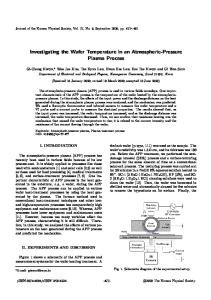Formation of plasma dust structures at atmospheric pressure
- PDF / 383,145 Bytes
- 13 Pages / 612 x 792 pts (letter) Page_size
- 87 Downloads / 373 Views
, NONLINEAR, AND SOFT MATTER PHYSICS
Formation of Plasma Dust Structures at Atmospheric Pressure A. V. Filippova,*, V. N. Babicheva, N. A. Dyatkoa, A. F. Pal’a, A. N. Starostina, M. D. Tarana, and V. E. Fortovb a State
Research Center of Russian Federation, Troitsk Institute for Innovation and Fusion Research, Troitsk, Moscow oblast, 142190 Russia b Institute for High Energy Densities, Russian Academy of Sciences, ul. Izhorskaya 13/19, Moscow, 127412 Russia *e-mail: [email protected] Received July 15, 2005
Abstract—The formation of strongly coupled stable dust structures in the plasma produced by an electron beam at atmospheric pressure was detected experimentally. Analytical expressions were derived for the ionization rate of a gas by an electron beam in an axially symmetric geometry by comparing experimental data with Monte Carlo calculations. Self-consistent one-dimensional simulations of the beam plasma were performed in the diffusion drift approximation of charged plasma particle transport with electron diffusion to determine the dust particle levitation conditions. Since almost all of the applied voltage drops on the cathode layer in the Thomson glow regime of a non-self-sustained gas discharge, a distribution of the electric field that grows toward the cathode is produced in it; this field together with the gravity produces a potential well in which the dust particles levitate to form a stable disk-shaped structure. The nonideality parameters of the dust component in the formation region of a highly ordered quasi-crystalline structure calculated using computational data for the dust particle charging problem were found to be higher than the critical value after exceeding which an ensemble of particles with a Yukawa interaction should pass to the crystalline state. PACS numbers: 52.27.Lw, 52.25.Jm, 52.65.–y DOI: 10.1134/S1063776106020154
1. INTRODUCTION At present, the physics of plasma in two-phase media, in gases with particles of the condensed disperse phase, is a rapidly developing field of science. The formation of crystalline structures and regions with sharp boundaries separating regions with greatly differing plasma parameters, the nucleation and growth of dust particles through coagulation, the dynamical heat and mass transfer, etc., have been actively studied in such plasma [1]. These studies were carried out mainly at low pressures, and there are currently few works devoted to the experimental investigation of a dust plasma at nearly atmospheric pressures [1]. These include experiments to investigate a thermal plasma containing particles of the condensed disperse phase that revealed liquidlike dust structures [2]; works to study a nuclear excited plasma with a low-intensity Cf252 source [3]; and works to investigate the influence of dust on the parameters of a pulsed non-self-sustained discharge [4, 5]. Studying a dust plasma at atmospheric pressure is of interest in developing a new, highly efficient method for converting nuclear energy into electric energy using radioactive fuel in the form of mic
Data Loading...











